Dogs and fireworks are usually not a fun—or safe—combination. Although many people enjoy celebrating holidays like the 4th of July with fireworks, most dogs are not fans. The sudden loud sounds and bright lights can be very startling to them. Integrative veterinarian Dr. Julie Buzby discusses ways to calm your dog’s fireworks anxiety, including what to give dogs for fireworks, so you can keep your pup safe while enjoying the summer celebrations.
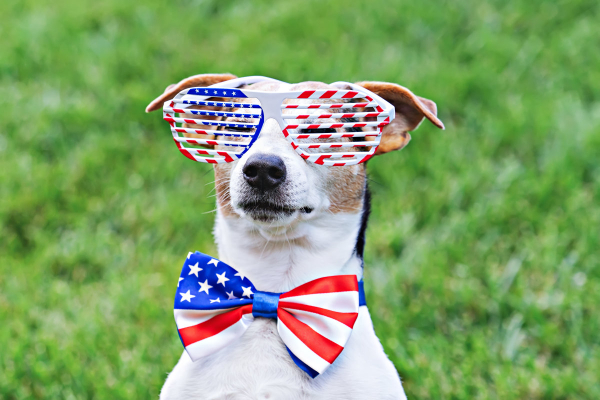
Why are dogs scared of fireworks?
Fireworks may elicit “oohs” and “ahhs” from us. But they are much more likely to terrify your dog than to awe him or her. Fireworks are loud for humans, so can you imagine what they are like for dogs? Our canine companions have very sensitive hearing—far more powerful than ours. This means the loud “pop” of a firework is magnified for them.
Plus, they aren’t expecting it. Loud noises like fireworks aren’t part of most dogs’ day-to-day life. And while we humans can look forward to a fireworks show starting with anticipation, the dog has no idea what is in store.
Additionally, fireworks come with bright flashes of light that can scare your dog. Other than thunderstorms (which dogs with fireworks anxiety are likely afraid of too), there aren’t a lot of other times when suddenly the whole sky lights up with a bang. Understandably, the light from fireworks can be alarming for dogs too.
Finally, fireworks are unpredictable. Your dog has no idea how long they are going to last or when the next “boom” and “flash” is going to occur. This leaves your dog on edge, unable to make sense of what is going on around him or her.
Fireworks and dogs don’t mix well
The combination of all these factors can make fireworks very stressful for dogs, so much so that they may trigger a dog’s fight-or-flight response. The dog may panic and bolt to try to escape the intense noise. This is a big part of why more pets get lost around the Fourth of July than any other time of year.
And if your dog doesn’t manage to get away, he or she may destroy windows and doors, or injure him or herself in the midst of a frantic escape effort. All in all, dogs and fireworks are usually a bad combination.
However, the good news is that if your dog is scared of fireworks, there are strategies you can put in place now to help reduce anxiety and calm your dog.
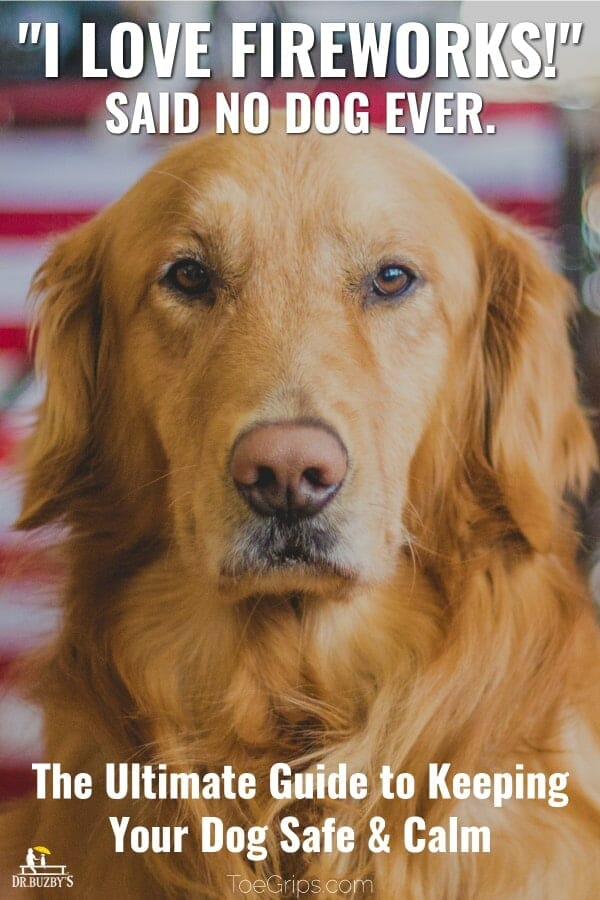
What can you give your dog for fireworks anxiety?
1. Before fireworks season begins, speak with your dog’s vet about anti-anxiety products.
If your dog has mild anxiety with the fireworks, you may want to speak with your veterinarian about dog calming nutraceuticals (i.e. nutritional supplements) and/or synthetic pheromones. Nutraceuticals including CBD oil for dogs and certain calming treats may be helpful for a dog who is afraid of fireworks. And products like Adaptil that mimic the pheromones secreted by nursing mother dogs can have a calming effect.
For some dogs whose anxiety is on the milder side, this can be enough to “take the edge off.” And typically these products don’t have the side effects we sometimes see with prescription anti-anxiety medications. Thus, it is worth talking to your vet about which over-the-counter options may help reduce your dog’s mild fear of fireworks.
What about Benadryl for dogs for fireworks?
If you notice, Benadryl for dogs did not show up in the paragraph above on ways to decrease a dog’s fireworks anxiety. Here’s why. One of the side effects of Benadryl is mild drowsiness. So from the outside looking in, it would stand to reason that Benadryl could potentially help keep dogs calm during the fireworks.
But the problem with using Benadryl for dogs for fireworks is that while it may make dogs sleepy, it does nothing to decrease their anxiety. At best, with Benadryl, your dog may be a bit drowsy. But he or she will still be every bit as scared as before. So it doesn’t really address the underlying problem—your dog’s fear and anxiety.
Therefore, if you are looking for a medication you can give anxious dogs before the fireworks, I generally recommend using a veterinarian-prescribed anti-anxiety medication rather than reaching for the Benadryl.
2. If your dog has moderate to severe anxiety, speak with your vet about prescription anti-anxiety medications.
If your dog has moderate to severe anxiety surrounding fireworks, speak with your veterinarian about prescription anti-anxiety medications such as trazodone for dogs. Many safe, effective medication options are available. And the great thing about these medications is that, unlike a sedative, which may make your dog tired but doesn’t change the fear he or she is experiencing, anti-anxiety medications reduce the anxiety your dog feels so he or she can stay calm internally as well as externally.
Since each medication is a bit different, your veterinarian will give you specific instructions about how to use the medication. In general though, it is important to remember that most anti-anxiety medications need to be in your dog’s system well before the fireworks start. Thus, it is important to plan ahead so you can give your dog the medication at the recommended time.
A bit of a veterinary soapbox: Please make an effort to discuss these options with your veterinarian well in advance of “fireworks holidays” like July 4th and New Year’s Eve. Veterinary staffs often find themselves scrambling to fill prescription requests fast enough on July 3! I also sometimes recommend giving “test doses” of new anxiety medications on a non-stressful evening to monitor for any unwanted side effects.
Additionally, it is very important to note that you should never treat your dog with your own medications. Only use veterinary-prescribed medications in accordance with the directions on the label. And do not decide to increase your dog’s anti-anxiety medication dose on your own.
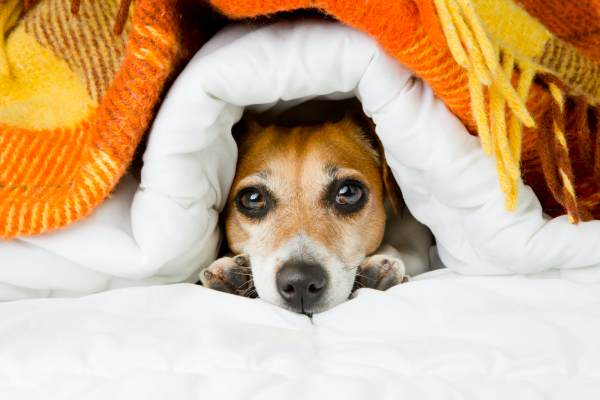
How to calm a dog during fireworks (and keep them safe): 9 Tips
In addition to talking with your vet about calming supplements, pheromones, or anti-anxiety medications, keep these nine tips in mind for helping keep your dog calm and safe during the fireworks displays.
1. Keep your dog safely indoors during fireworks.
This is key—keep your dog indoors during fireworks and make sure he or she is wearing a collar with proper identification (e.g. id tags). A scared dog is way more likely to run off, even if he or she is typically your shadow. And fireworks or sparklers can injure dogs if their curiosity leads them too close to the action. For example, attempting to sniff, lick, or bite a sparkler or lit firework can cause serious burns.
Ideally, in addition to keeping your dog inside, you should also stay at home with your dog during the fireworks displays. If you’re having visitors, inform them that it is critical for your dog to stay inside, accounted for, and in a safe place. You may also want to explain to guests that your dog may be frightened and need some extra space. And you should have all household members be very cautious when opening doors to prevent your dog from slipping out.
2. Diminish the sound of the fireworks by playing calming music.
If your dog is afraid of loud noises, lessen the sounds of fireworks by playing music as white noise. There’s now a cadre of data that music can be helpful in reducing stress and anxiety in pets. If you don’t have a specific dog relaxation playlist, classical music is a good option.
Additionally, most smart home devices are capable of playing white noise. But keep in mind that static or rain noises may increase stress in dogs with thunderstorm phobias. Give it a trial run to see how your dog reacts to different sound options before the fireworks kick off. And then plan to play whatever works best for your dog.
Alternatively, you could consider turning on the TV. You don’t want it to be so loud that the volume is a stress in and of itself. But it should be loud enough to diminish the impact that the sound of the fireworks is having on your dog.
3. Consider trying out some dog ear muffs for fireworks
You can buy a variety of dog ear muffs, headphones, or hoods that could potentially dampen the sound of the fireworks. This option is, however, dependent on your dog tolerating having the earmuff or hood on his or her head. For some dogs, this may be no big deal. But other dogs may prefer not to have anything covering their ears or around their heads, especially when they are already scared or feeling trapped.
If you do decide to try out some dog ear muffs, start getting your dog used to them well in advance of the fireworks. This preparation is critical. The night of the fireworks is not the time to put the earmuffs on an already-scared dog for the first time!
To help your dog accept the ear muffs, put them on your dog for a few minutes (or maybe even less at first). And give your dog a high-value treat to associate the ear muffs with good things. Over time, you can gradually increase the amount of time your dog is wearing the ear muffs.
4. Create a safe space where your dog is most comfortable.
If your dog is afraid of fireworks, make sure to provide him or her a safe haven. For example, if your pup likes the crate, it can be a safe den-like space. Or some dogs may prefer to retreat to a closet, bathroom, or other windowless room. That way they can’t see the flashes of light.
Being in an environment that feels safe will help your dog remain calm as he or she gets through the noise phobia. Plus, having your dog secured in a safe place also helps decrease the chances he or she could bolt out the door and get lost.
If having you near seems comforting, you may want to stay in the safe haven with your dog. Or you can give your dog a lick mat, puzzle toy, or other activity to do while in the safe place. Keeping your dog’s brain engaged can help distract him or her from the fireworks. And licking is calming for many dogs.
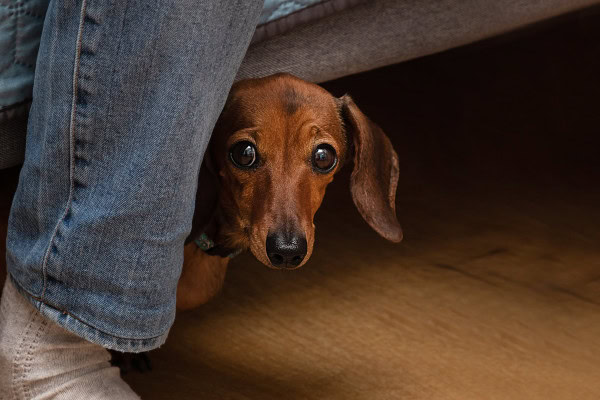
5. Try a body wrap before the fireworks begin and when your dog is still calm.
Anxiety vests such as the Thundershirt® can help calm some dogs who are scared of fireworks. I always think of the wrap compression as giving a gentle hug, which releases calming endorphins. For more information on how to use a comfort wrap for maximum calm, please follow Thundershirt’s® tips for best results. Just like the synthetic pheromone treatment, wraps such as Thundershirt are typically most effective at quelling mild anxiety.
6. Attempt to desensitize your dog to fireworks before they happen
Sometimes you can help your dog get used to the sound of fireworks using a technique called desensitization. This involves playing the sound of fireworks at a low enough volume that your dog notices it but isn’t afraid, and paring that with a high-value treat. Ideally, over time, you will be able to turn up the volume more and more. And eventually your dog will no longer see fireworks as a threat, or at least be less worried about them.
7. Work with a veterinary behaviorist or dog trainer
If your dog has severe fireworks anxiety, or fireworks anxiety plus other types of anxiety (e.g. noise phobias or separation anxiety), it can be helpful to enlist the help of a veterinary behaviorist or dog trainer. A veterinary behavior specialist can prescribe anti-anxiety medications as well as work on behavior modification. On the other hand, a dog trainer focuses of the behavior aspect only.
Your veterinarian may be able to direct you to the person best suited to help your dog, be that a trainer or a veterinary behaviorist.
8. Take your dog for a long walk or run before the fireworks
Some dog owners have found it helpful to take their dog for a long walk or run or have an intensive play session before the fireworks start. A dog who is worn out is less likely to react as strongly to the fireworks as one who is full of pent-up energy. Plus, getting outside before the fireworks allows your dog to go to the bathroom when all is still quiet.
9. Check your yard and your walking route for firework debris
Once the fireworks finish, it is important to look for any firework pieces, unused firework, or other debris in your yard. If you find any, pick it up before letting your dog outside. Additionally, you should be vigilant in looking for firework debris along your walking paths.
This is critical because some dogs have been known to eat fireworks or firework debris, both of which are toxic to dogs. The chemicals they contain can cause GI upset (vomiting and diarrhea—which is sometimes bloody), abdominal pain, kidney failure in dogs, tremors, or seizures.
Thus, if your dog eats fireworks or firework debris, contact an emergency vet or animal poison control center immediately.
Work with your veterinarian
If your dog is scared of the sound of fireworks, ask your veterinarian about these or other solutions. You can use most of these options in combination with each other. Just remember, like us, dogs are individuals. And it may take some trial and error to tailor a plan that works best for your pup.
For safety, make sure your dog is microchipped
All of these techniques can help decrease fireworks anxiety. But sometimes the unthinkable happens and your dog bolts out the door or slips out of the collar or harness in a panic while outside. In that situation, having your dog microchipped is a lost pet prevention tip that can help get your beloved companion back home quickly and safely.
Microchips are small devices—about the size of a grain of rice—that are implanted under your dog’s skin. Usually the microchip is placed right between the shoulder blades. The procedure to implant them is minimally painful (basically like a big shot) and can be done while your dog is awake. Some breeders or shelters may microchip their dogs before adoption. Or you can ask your vet to microchip your dog during an appointment.
Important PSA: If your canine companion already has a microchip, make sure your contact information is up to date! It is so heartbreaking when veterinarians scan found animals and find a microchip, only to discover that no one registered the chip or it has out-of-date contact information. Without up-to-date information, the chip can’t help veterinarians reunite lost animals with their pet parents.
If you’re not sure whether your furry friend is microchipped, or whether the microchip information is up to date, ask your vet to scan your dog and record the microchip number for you. Then you can look up your dog’s unique microchip identification number on the American Animal Hospital Association’s pet microchip search page. This resource allows you to see if the chip is registered, and with which organizations.
7 more summer hazards and how to keep your dog safe
In addition to keeping our dogs calm and safe from fireworks, there are many other hazards that go hand-in-hand with 4th of July or other summer celebrations. Common items like glow sticks, corn cobs, and insect repellents don’t get as much “airtime” as fireworks. But none the less, they can cause your dog serious harm or stress.
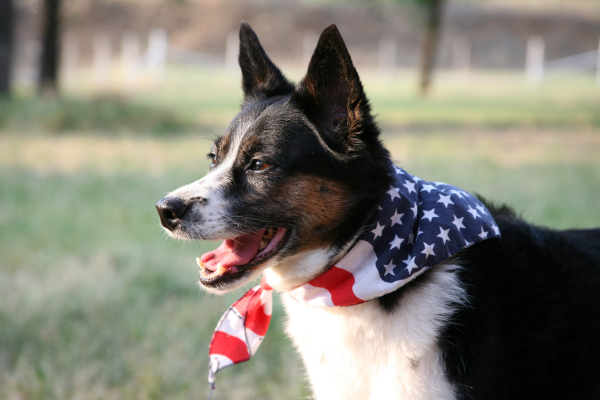
That’s why, as you prepare your pup for the fireworks, I encourage you have a strategy in place for the entire day or weekend. Read on for seven more hidden hazards associated with fireworks festivities.
1. Leftovers and table scraps
Ingestion of table scraps may cause your dog to have an upset stomach. Symptoms may include vomiting, diarrhea, and inappetence. Additionally, this could develop into a more serious condition known as pancreatitis in dogs. This is a very painful and life-threatening condition where the dog’s pancreas becomes inflamed.
In addition to table scraps, watch out for these hazards:
- Skewers from kabobs—If swallowed, skewers can puncture your dog’s stomach or intestines. I know some dogs (looking at you, Labs!) loiter around the grill waiting for an opportunity to snatch a snack.
- Corn cobs—They will not pass through your dog’s intestinal tract and require surgical removal if ingested.
- Garbage—Lastly, make sure your dog does not get into the trash. The lingo we use for this in veterinary medicine is “garbage gut.” Depending on the contents in the trash, this can be a life-threatening emergency. Typically, symptoms may include gastrointestinal signs, vomiting, inappetence, and diarrhea.
Fortunately, there are some vegetables dogs can eat (and may even love) that are healthy and make great treats.
2. Alcohol
Keep alcoholic beverages out of reach of dogs, and do not leave your drink unattended. Consumption of alcoholic beverages can cause dogs to exhibit neurologic symptoms—including coma, in severe cases.
3. Heat and humidity
In most areas of the country, 4th of July is accompanied by sweltering summer heat. That’s why it’s important to be aware of heat stroke in dogs, which is a life-threatening medical emergency.
Symptoms of a dog overheating include panting, drooling, and weakness. And if the dog begins to suffer from heat stroke, he or she may also seem disoriented, experience vomiting and/or diarrhea, and even collapse. Should you see these signs, make an emergency vet visit immediately.
Breeds with flat faces, such as Bulldogs and Pugs, are at a greater risk for heat stroke. But it is important to know how to keep your dog cool in the summer and how to cool down a dog no matter what breed of dog you have.
Additionally, if you’re celebrating outdoors with your dog, it is important to be mindful of the temperature of the ground. Asphalt absorbs heat and can be significantly hotter than ambient temperature. Unfortunately, I’ve treated several paw pad burns (a type of dog paw pad injury) for dogs who stood on hot pavement. It’s best to keep your dog in a shaded and/or grassy area to keep the feet free from injury.
4. Insect repellents
Insect repellents that are not labeled for pets may be toxic for dogs. They can cause symptoms including drooling, vomiting, diarrhea, being a lethargic dog, and neurological signs (e.g. muscle tremors and seizures in dogs).
Keeping your dog current on monthly veterinary-prescribed heartworm and flea/tick prevention is the best solution to combatting insects. Also, if you spray insect repellant on yourself, be sure to do so in a well ventilated area away from dogs.
5. Citronella candles and tiki torches
Besides the obvious burn risk that citronella candles and tiki torches present, citronella can harm dogs’ gastrointestinal and nervous systems. And the fumes can cause lung irritation. So it is best to keep citronella candles and tiki torches away from dogs.
6. Lighter fluid and liquid matches
Matches contain chemicals which, if ingested in sufficient quantities, can damage a dog’s red blood cells and cause gastrointestinal upset. Lighter fluid can irritate a dog’s skin and mouth upon contact and also cause gastrointestinal problems if ingested. During 4th of July picnics (and every day) keep these products safely away from your dog.
7. Glow sticks and glowing necklaces
Lastly, many fireworks celebrations include glow sticks, glow necklaces, and other glow jewelry for guests to wear in the dark. If a dog ingests these, the chemicals in glow products can cause drooling (a common sign of nausea) and stomach irritation. Also, the plastic, if ingested, can cause an intestinal blockage which may require surgery. Additionally, you should NEVER put glow products on your dog.
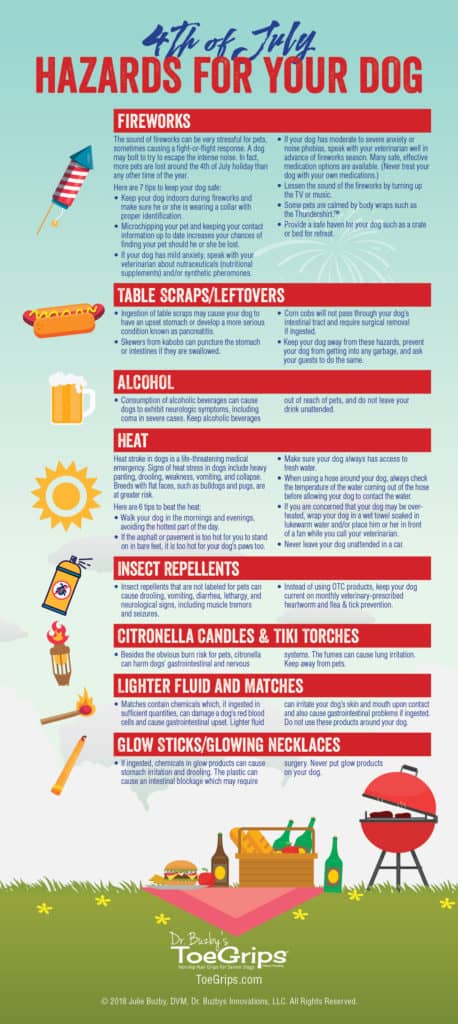
Get prepped and be proactive
Fireworks season and summer celebrations are a time when all dog parents need to be extra vigilant to help keep their dogs safe, calm, and anxiety-free. By planning ahead, speaking with your vet about strategies to calm your dog during fireworks, and knowing all the other hidden dangers for dogs lurking in our summer celebrations, you’ll be prepared for anything.
You and your dog can enjoy a happier, safer, and healthier summer together. And that is brighter and better than even the biggest fireworks display.
What fireworks or summer safety concerns do you have for your dog?
Please comment below. We can all learn from each other.


How can you treat sore paws from the hot ground. My dog has tinder paws because my grandpa Took him out for a walk when I was at swim practice and I don’t know how to relive his pain it isn’t bad enough to need a vet visit but he is a Service dog and has a job to do but I don’t want to take him out with his paws being tender please help. And I would also like to know ways to prevent this from happening again.
Thank you for the question. I’m so sorry to hear that your dog’s paws were burned. The best way to protect your dog’s paws on the hot pavement are:
1. avoid walking on the hot pavement altogether ie. walk on grass or in the cool of the morning
2. https://www.pawzdogboots.com/
3. other types of dog boots
Whenever a dog is injured, I recommend seeking care from a veterinarian, especially because the dog cannot speak for himself.